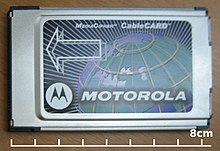
CableCARD is a special-use PC Card device that allows consumers in the United States to view and record digital cable television channels on digital video recorders, personal computers and television sets on equipment such as a set-top box not provided by a cable television company. The card is usually provided by the local cable operator, typically for a nominal monthly fee.
In a broader context, CableCARD refers to a set of technologies created by the United States cable television industry to allow devices from non-cable companies to access content on the cable networks. Some technologies not only refer to the physical card, but also to a device ("Host") that uses the card. Some CableCARD technologies can be used with devices that have no physical CableCARD.
The CableCARD was the outcome of a U.S. federal government objective, directed in the Telecommunications Act of 1996, to provide a robust competitive retail market for set-top boxes so consumers did not have to use proprietary equipment from the cable operators. It was believed that this would provide consumers with more choices and lower costs.
A 2020 FCC decision removed the requirement for cable companies to provide CableCARDs, but they are still required to provide consumer access options via "separable security".[1]
- ^ September 2020, Gary Arlen 10 (2020-09-10). "FCC Abandons CableCARD, Navigation Devices Rule Review". Multichannel News. Retrieved 2021-07-31.
{{cite web}}: CS1 maint: numeric names: authors list (link)